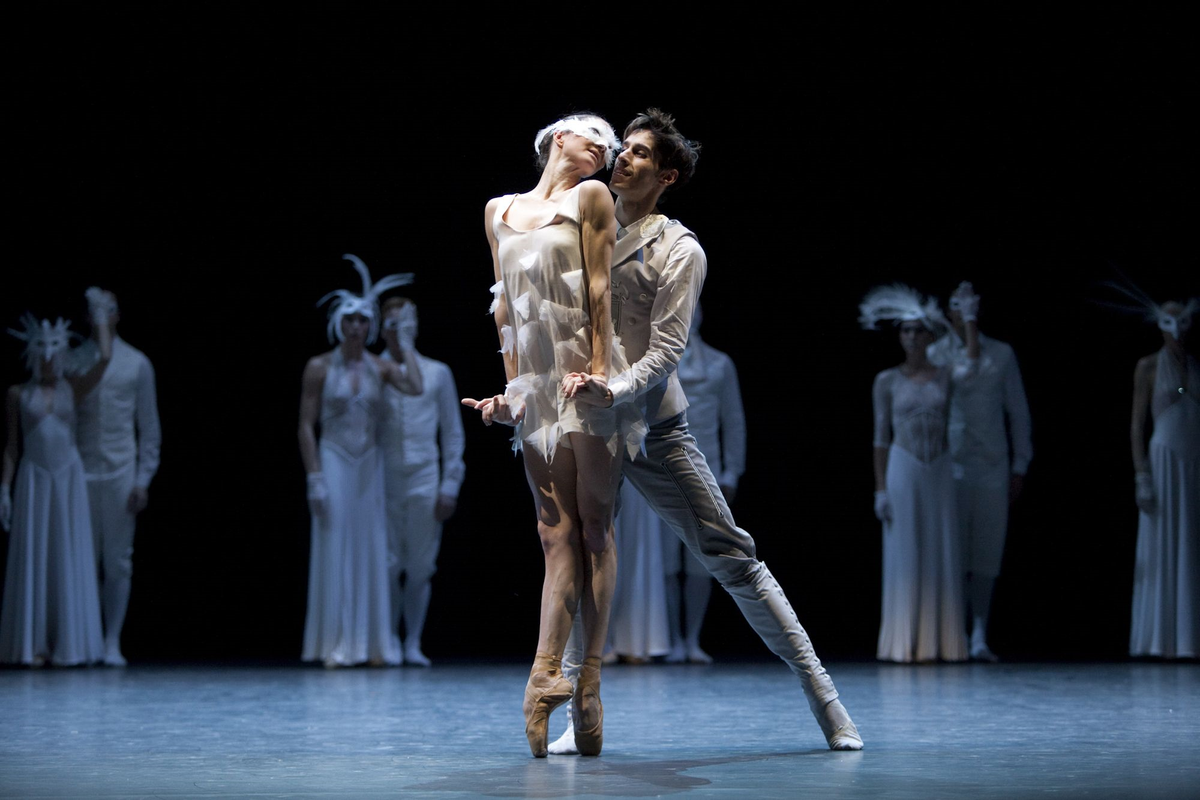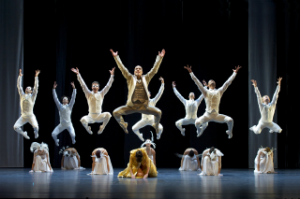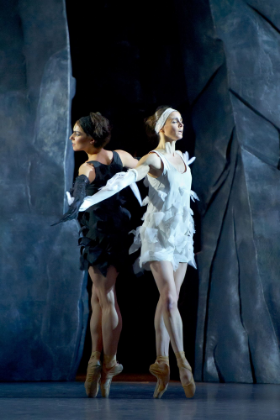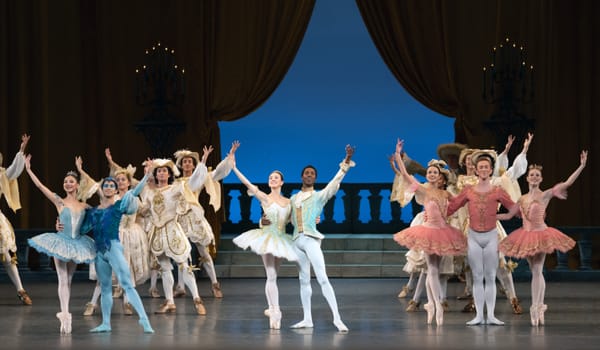Swans of the Night

“LAC (after Swan Lake)”
Les Ballets de Monte-Carlo
New York City Center
New York, NY
March 14, 2014
Reinterpreting a beloved classic is risky business, and in the case of “Swan Lake” akin to a tightrope walk over a yawning chasm. The few examples that got all the way across distanced themselves from the original with enough creative merit to minimize comparison. Les Ballets de Monte-Carlo’s “LAC” sought to follow suit. Choreographed by Jean-Christophe Maillot in 2011 to Tchaikovsky’s score with additional music by the choreographer’s brother, Bertrand Maillot, the work is a fusion of classical and modern styles, and significantly alters the story, costumes and nature of the characters. The result is no masterpiece, but every now and then it made you forget the original long enough to be enjoyable on its own.
Maillot’s choreography illustrated the characters’ natures and served as a convenient vehicle for the dancers to express them. It didn’t hurt that the troupe boasted technically and physically superb performers. Almost every female had remarkably arched feet and sublime leg lines; almost every man had natural ballon. Their precision and musicality amplified Maillot’s composition.
At its core the plot of “LAC” was familiar: there was a prince, a black swan and a white one, and an evil sorcerer who tricked the prince. But the story’s details were completely rewritten by dramaturge Jean Rouaud, who gave the ballet an updated and darker libretto. The sorcerer was replaced by a devious, but oddly alluring, female character called Her Majesty the Night. And in addition to the main love triangle, Maillot’s ballet featured a subplot: The Prince’s father, the King, was attracted to this interloper, much to the chagrin of the Queen, and there were hints of an affair that resulted in the Black Swan.
But the conception wasn’t just a modified plotline with updated steps and modernized costumes (not a tutu in sight). It was also an unabashed portrayal of the characters at their most primal. The swans here were wild birds, not swan-maidens, full of feral instincts constantly reverberating in their jerking movement. They didn’t seem to be captives of Her Majesty – at best they were her reluctant subjects. The humans were also stripped of fairytale pretenses; their flaws, weaknesses and untamed desires were bared for all to see. Incest, adultery, murder, unguarded passions – it’s all fair game in “LAC.”

From the ballet’s opening scene (also its weakest), the gratuitously sexualized choreography, laced with acrobatics and limb thrusts, underscored that these people were driven by impulse, not emotion or sense. Even the potential brides were each avatars of human foibles. First, there was the Conceited Woman, danced by Liisa Hämäläinen, whose leg presentations and delicate port de bras were too beautifully refined to be vain. Then came the Indifferent Pretender, dehumanized in her coolness. She was followed by two Libertines, who bickered with each other like the step-sisters from “Cinderella.” Finally, there was the Insatiable Woman in a long red dress whose aggressive pursuit was terrifying to the Prince. He rejected them all, and for a brief moment we could believe that he, at least, was a virtuous character holding out for the pure White Swan. But in this version he met the Black Swan first, and revelations of his own failings quickly followed.
The catalyst and star of this production was Her Majesty the Night, who appeared soon after the faulty brides. Her spectacular entrance, carried onstage by three men concealed under her skirt, made her look twice as tall as everyone else, and twice as intriguing. Maude Sabourin’s interpretation of the role was dark and brewing with concealed energy, never still for a second. Even when Maillot had her stay in one place, there was a constant adjustment of the leg here, a self-caressing move of the arm there. It made you think that the plan she was setting in motion was far from the limits of her hidden powers.
In her first dance Sabourin resembled a coiling snake: retreating to deep, earthbound pliés and thrashing out into high-limbed poses. She reveled in the effect she was having on the others: victorious with the King’s swooning and amused by the Queen’s fear. This world was her playground.
When Her Majesty was done with her own introduction, she presented her daughter, the Black Swan, danced by April Ball. As soon as Ball entered it became clear that the Prince, Stephan Bourgond, wasn’t the gallant hero of “Swan Lake” that we’ve come to admire despite his foolishness. Bourgond played the Prince as a naïve, even cowardly, young man blinded by the sensual appeal of Ball’s Black Swan. He hung on her every move, even as she pecked, birdlike, at his heart during one of their first encounters.
Bourgond’s infatuation was strange, as there was little to fall for in Ball’s anti-heroine. Anyone who wasn’t her prey could see she was a callous seductress who broke hearts for sport. Unlike Sabourin, Ball didn’t have extraordinary facility, and instead she focused on sensuality. The mystique of her assertive moves, like the seductive way in which she would pull her hands away from Bourgond, yet maintain her gaze, kept your focus and overshadowed any physical shortcomings.
Maillot used the adagio music from the black swan pas de deux for side-by-side duets of two fascinatingly different seductions: the inexperienced courtship of the Prince and the Black Swan and the seasoned enticement of the King and Her Majesty the Night. The Prince seemed enraptured and fascinated with his partner, but unsure of the right approach to such a tempting creature. The King was senselessly in awe of Her Majesty, voraciously rekindling an old affair. At times the choreography was identical in the duets, juxtaposing these two disturbing rituals. The scene was foreboding enough to make the Queen cover her eyes.

The swans arrived in the second half of the ballet, after the audience had time to soak in this unfamiliar character dynamic. Dressed in feathered leotards and modern tunics and first appearing in feathered gloves which made their arms look like wings even without any movement, they were more birds than bird-women, yet seemingly at ease with their situation. Anja Behrend as the White Swan was the only one in the flock to show apprehension. Behrend’s heroine was a tender, fragile figure passively resigned to her feathered fate, but unlike the others not overtaken by the avian instincts. Her softer, more innocent approach to each movement and position set her apart from the rest of the swans, particularly the Black Swan, with whom she often shared the stage.
Unsurprisingly the Prince was drawn to the White Swan in a more profound way. Their adagio didn’t have the classicism of the original, and instead of trying to outchoreograph the traditional steps Maillot turned the movements into a physical dialogue. Their interaction was at times childlike, reminding the Prince that the White Swan was the same girl he once met and loved as a child (a backstory told by a short silent film at the beginning of the performance), and for a welcome moment the two of them embodied youthful innocence.
Alas, the long awaited lakeside section wasn’t extraordinary enough and made you nostalgic for the iconic Ivanov choreography that went with its music. The frequent crudeness in these swans’ movements made them more feral, but also placed them out of synchrony with Tchaikovsky’s refined melodies. The absence of familiar corps patterns succeeded at making the swans look undomesticated, but also made their dance scenes distractingly chaotic.
Still, Maillot achieved some exceptional choreographic novelties. The swans’ unique arm positions looked more wing-like than the tried and true poses and movements of the traditional “Swan Lake.” The most memorable had both of the White Swan’s arms folded on the side of her body, her torso leaning in, with elbows curved and facing the same direction, subtly moving like real wings. Even if they were a far cry from the classic ballet’s captivating qualities, these details made the scenes interesting enough to keep you watching.
The rest of the story unraveled too quickly after the ballet’s earlier pace. The Prince announced his bride-to-be, Her Majesty surprised everyone by presenting the White Swan and a wedding took place, but the brides were swapped during the ceremony precluding a happy ending. The rest of the plot imploded even quicker: the Queen killed the Black Swan in dubiously triumphant revenge, the White Swan went back to her bird form, and in an overdramatic final scene at the lake a beautiful black silk veil fell from the ceiling swirling and making the cast disappear into the night.
In the end, even if you weren’t wild for Maillot’s corybantic excesses, they still left you entertained.
copyright © 2014 by Marianne Adams



